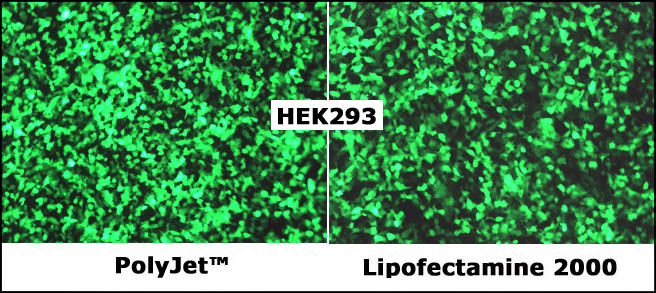标题:美国SignaGen转染试剂-- PolyJet™ (2)
Examples Showing Transfection Efficiency of PolyJet™ DNA In Vitro Transfection Reagent on Commonly Used Cells
Transfection efficiency comparison of PolyJet™ vs. lipofectamine Plus on Chinese Hamster Ovary (CHO) cells. HA tagged beta-tubulin cDNA was delivered into CHO cells with PolyJet™ (left panel) and lipofectamine Plus (right panel) respectively. FITC conjugated antibody against HA tag was utilized to pick up HA-beta-tubulin (Green) while a DM1a antibody was used to detect endogenous alpha-tubulin followed by probing with rhodamine conjugated secondary antibody (Red). The above picture was provided by Dr. Shang Yin of University of Texas at Houston Medical School as courtesy
A comparison showing transfection efficiency of PolyJet™ reagent vs. a leading product, Lipofectamine 2000 on HEK293FT cells. HEK-293FT cells were transfected with GFP vector (pEGFP-N3) by PolyJet™ (left panel) and Lipofectamine 2000 (right panel) respectively. The cells were visualized by Nikon Eclipse Fluorescence microscope 24 hours post transfection
A comparison showing transfection efficiency of PolyJet™ reagent vs. a leading product, Lipofectamine 2000 on HepG2 cells. HepG2 cells were transfected with GFP vector (pEGFP-N3) by PolyJet™ (left panel) and Lipofectamine 2000 (right panel) respectively. The cells were visualized by Nikon Eclipse Fluorescence microscope 24 hours post transfection
Transfection efficiency comparison of PolyJet™ vs. Fugene HD on MDCK cells. A plain GFP DNA was transduced into MDCK cells with PolyJet™ (left panel) and Fugene HD (right panel) reagents respectively per manufacturers' protocols. GFP and DAPI staining were visualized under fluorescence microscopy 48 hours post tansfection. The above comparison data and pictures were completed and provided by Dr. Ge Zhou of NYU Medical Center as courtesy

Transfection efficiency comparison of PolyJet™ vs. lipofectamine Plus on Chinese Hamster Ovary (CHO) cells. HA tagged beta-tubulin cDNA was delivered into CHO cells with PolyJet™ (left panel) and lipofectamine Plus (right panel) respectively. FITC conjugated antibody against HA tag was utilized to pick up HA-beta-tubulin (Green) while a DM1a antibody was used to detect endogenous alpha-tubulin followed by probing with rhodamine conjugated secondary antibody (Red). The above picture was provided by Dr. Shang Yin of University of Texas at Houston Medical School as courtesy
A comparison showing transfection efficiency of PolyJet™ reagent vs. a leading product, Lipofectamine 2000 on HEK293FT cells. HEK-293FT cells were transfected with GFP vector (pEGFP-N3) by PolyJet™ (left panel) and Lipofectamine 2000 (right panel) respectively. The cells were visualized by Nikon Eclipse Fluorescence microscope 24 hours post transfection
A comparison showing transfection efficiency of PolyJet™ reagent vs. a leading product, Lipofectamine 2000 on HepG2 cells. HepG2 cells were transfected with GFP vector (pEGFP-N3) by PolyJet™ (left panel) and Lipofectamine 2000 (right panel) respectively. The cells were visualized by Nikon Eclipse Fluorescence microscope 24 hours post transfection
Transfection efficiency comparison of PolyJet™ vs. Fugene HD on MDCK cells. A plain GFP DNA was transduced into MDCK cells with PolyJet™ (left panel) and Fugene HD (right panel) reagents respectively per manufacturers' protocols. GFP and DAPI staining were visualized under fluorescence microscopy 48 hours post tansfection. The above comparison data and pictures were completed and provided by Dr. Ge Zhou of NYU Medical Center as courtesy